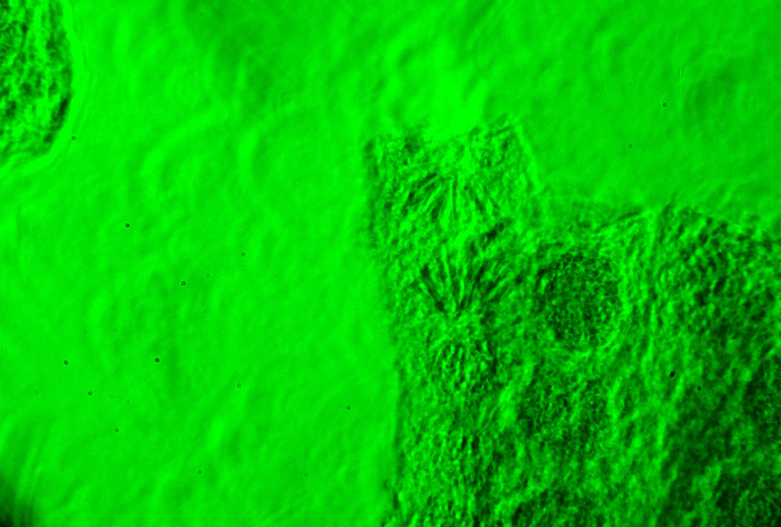Childrens activity looking at real chromsomes through a microscope

Garlic root tip squash image taken during activity at about 1000x magnification.
This practical activity with children as young as 7 years old, was arranged at short notice due to the weather being unsuitable for the original outdoor event with flying kites.
Garlic clove sprouting root tips were fixed in vinegar, softened with Harpic which has an MSDS Data sheet listing 5% Hydrochloric Acid, then gently squashed out into a single layer of cells between a cover slip and a microscope slide.
The green colour is because the oblique phase contrast illumination set up on the ancient Cooke Troughton and Simms binocular laboratory microscope has a phase plate objective for use with green light.
The children made drawings of the 'tangled bits of string' , as they described the actual appearance of the chromosomes, being able to talk about and identify the sequences of the strings pulling apart within the individual growing root tip cells.
No technical scientific terms were used, it was all about some messy, smelly kitchen science with garlic cloves, then immediately looking through the microscope, observing closely and asking questions. Of great interest to the children was being able to actually see where all the famous 'DNA' was found in these cells and make an exciting discovery for themselves about what people meant when they talked about genetics, DNA and chromosomes.
A basic description sheet of the biology and sources for more information was available for the children to take away at the end of session. Some used this to annotate their drawings.
A well set up binocular eyepiece microscope is essential for this kind of activity, to make the use of specialist equipment not available in schools as seamless and accessible as possible.
Oblique phase contrast is an unusual technique for viewing details in biological specimens without needing to stain them first. The view is like a 3D landscape.
Garlic clove sprouting root tips were fixed in vinegar, softened with Harpic which has an MSDS Data sheet listing 5% Hydrochloric Acid, then gently squashed out into a single layer of cells between a cover slip and a microscope slide.
The green colour is because the oblique phase contrast illumination set up on the ancient Cooke Troughton and Simms binocular laboratory microscope has a phase plate objective for use with green light.
The children made drawings of the 'tangled bits of string' , as they described the actual appearance of the chromosomes, being able to talk about and identify the sequences of the strings pulling apart within the individual growing root tip cells.
No technical scientific terms were used, it was all about some messy, smelly kitchen science with garlic cloves, then immediately looking through the microscope, observing closely and asking questions. Of great interest to the children was being able to actually see where all the famous 'DNA' was found in these cells and make an exciting discovery for themselves about what people meant when they talked about genetics, DNA and chromosomes.
A basic description sheet of the biology and sources for more information was available for the children to take away at the end of session. Some used this to annotate their drawings.
A well set up binocular eyepiece microscope is essential for this kind of activity, to make the use of specialist equipment not available in schools as seamless and accessible as possible.
Oblique phase contrast is an unusual technique for viewing details in biological specimens without needing to stain them first. The view is like a 3D landscape.
